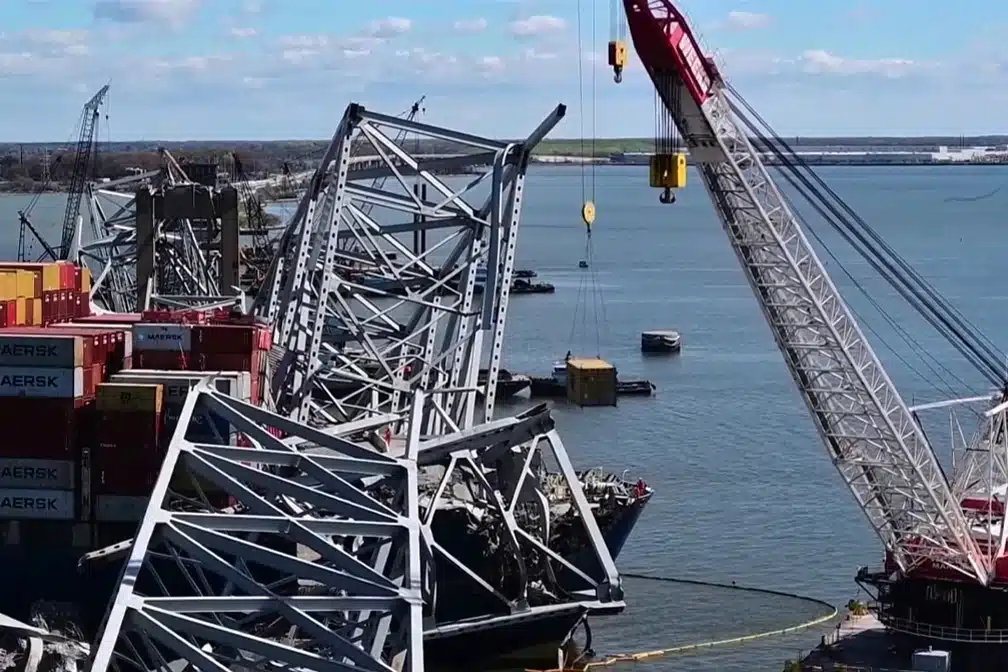April 2024 Truck and Warehouse Jobs shift, with trucking losing 300 jobs, and warehouses adding 7,600 jobs - highlighting industry volatility.
Continue Reading
May 19, 2024 1:04 pm

In the wake of the Francis Scott Key Bridge collapse in Baltimore, Maryland, a critical development has emerged, impacting truckers and the trucking industry nationwide. Let’s dive right into how the government is stepping up to tackle this crisis. We’re going to break down what changes are happening now, when we might see things get back on track, and why truckers should keep an ear to the ground.
Following the sudden collapse of the Francis Scott Key Bridge, the Federal Motor Carrier Safety Administration (FMCSA) swiftly enacted measures to reduce disruption in transportation operations. Recognizing the critical role truckers play in maintaining the flow of essential goods, the FMCSA has granted a temporary extension of the hours-of-service (HOS) regulations.
Under the emergency declaration, truck drivers navigating the affected routes can now drive for up to 13 hours within a 24-hour period, a modest bump from the standard 11-hour limit. This break, planned to hold until May 9 or when the crisis winds down, has been set in order to make it easier to move goods such as fuel, propane, and large equipment.
For years, the Francis Scott Key Bridge has been a lifeline, not just for commuters and goods moving across but also connecting industrial areas spanning the Patapsco River. When the bridge suddenly fell apart, not only did local roads turn into a nightmare, but truckers faced huge headaches too. Moving dangerous goods and big loads became especially tricky, throwing a wrench in the works for the entire trucking world.
With alternative routes through the Fort McHenry (I-95) and Baltimore Harbor (I-895) tunnels being unsuitable for certain cargoes, the incident has brought about a need to reevaluate logistics strategies for the affected area.
Stretching out trucker HOS plays a vital role in keeping our supply chain smooth and secure, ensuring that all essential goods get where it needs to be without a hitch. The collapse and the need to find new routes both highlight how delicate our roads and bridges are, not to mention the huge effect on the industry as a whole. Extending trucker HOS might seem like a quick fix, but it shines a light on how much strategic planning and flexibility the industry needs to be ready to implement at a moment’s notice. When the unexpected happens, the industry needs to be able to react swiftly.
The Maryland Port Administration announced that, by the end of May, they are planning to have the harbor’s channel open again. This is a big move towards getting things back to normal. However, complete repairs and fully recovery are thought to take quite a bit more time, signaling there are some serious hurdles ahead.
The trucking community seems pleased with the FMCSA’s choice to extend trucker HOS. They see it as an important move to keep vital goods moving smoothly, especially when times get tough. But this shift also makes many wonder about the future. How will these changes affect the way things run in the trucking world? What does this mean for our hardworking truck drivers’ health and happiness?
Experts in the industry are pushing to pour more resources into making our infrastructure tough as nails. They believe that a solid game plan should be in place to lessen the blow of any similar incidents down the road. This scenario has kicked off a discussion about ways that travel routes could vary and possible methods of improving the flexibility of the worlds of transportation and supply chain management. All things that could better keep things moving in the case of emergencies.
The unexpected collapse of the Francis Scott Key Bridge and the need for trucker HOS to be extended both make it clear that we’re at a turning point in the industry. As all are tackling the challenges at hand, the importance of strength and flexibility in our infrastructure and supply chains becomes more obvious. Bouncing back and rebuilding after this major setback will show us what the industry is made of. As the harbor gets ready to open its gates again and plans for the bridge’s reconstruction start taking shape, it’s clear that the trucking industry, as always, will play a major role.
April 2024 Truck and Warehouse Jobs shift, with trucking losing 300 jobs, and warehouses adding 7,600 jobs - highlighting industry volatility.
Continue ReadingBritish Columbia is taking a stand against commercial truck drivers who compromise the safety of the province's highways by hitting overpasses. This move is not just about
Continue ReadingAs we move through 2024, the trucking industry faces an unprecedented challenge with cargo theft reaching new heights. Experts forecast this year to mark a continuation of
Continue ReadingThe American Trucking Associations (ATA) has expressed strong opposition to the Department of Justice's proposed rule of marijuana reclassification.
Continue ReadingIn an effort to increase efficiency and sustainability in Trucking, Phillips Industries has launched their new, advanced, stick-on solar panels
Continue ReadingThe 2024 CVSA International Roadcheck is scheduled for May 14-16. Over 72 hours, inspectors across the US will conduct nearly
Continue ReadingAutomated License Plate Readers are a major advance in law enforcement technology but they raise significant privacy and oversight challenges.
Continue ReadingThe EPA's latest emission standards detailed in a final rule issued on March 29 are sparking vigorous debate within the
Continue ReadingOOIDA • ATA • DOT • NASTC • WOMEN IN TRUCKING • NPTC • DRIVER RESOURCES • TDN STAFF • ARCHIVES • SITEMAP